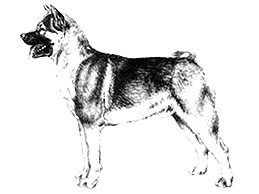Akita Breed Standard
Last updated: 22 Feb 2017
A breed standard is the guideline which describes the ideal characteristics, temperament, and appearance of a breed and ensures that the breed is fit for function with soundness essential. Breeders and judges should at all times be mindful of features which could be detrimental in any way to the health, welfare or soundness of this breed.

Kennel Club, London 1994
-
Group:
Group 6 (Utility)
-
History:
-
General Appearance:
Large, powerful alert, with much substance and heavy bone.
-
Characteristics:
Large, broad head, with relatively small eyes and erect ears carried forward in line with back of neck; large, curled tail, in balance with head.
-
Temperament:
Dignified, courageous, aloof, tends to show dominance over other dogs, though the trait is not encouraged.
-
Head And Skull:
Large, in balance with body, skull flat, forehead broad, defined stop and clear furrow. Head forms blunt triangle when viewed from above, free from wrinkle. Muzzle broad and strong, cheeks well developed. Nose large and black, bridge straight. Lips tight and black. In white dogs flesh coloured pigmentation is permissible on nose and lips. Length from nose to stop is to length from stop to occiput as 2 is to 3.
-
Eyes:
Relatively small, almond shaped, clean, moderately set apart and dark brown. Eye rims dark and tight.
-
Ears:
Strongly erect, relatively small, thick, triangular, not low set, carried forward over eyes in line with back of neck when viewed in profile. Moderately set apart; slightly rounded at tips.
-
Mouth:
Jaws strong, with a perfect, regular and complete scissor bite, i.e. the upper teeth closely overlapping the lower teeth and set square to the jaws.
-
Neck:
Thick and muscular, comparatively short, widening gradually toward shoulders. Pronounced crest blends with back of skull.
-
Forequarters:
Shoulders strong and powerful, moderately laid back. Elbows very tight. Forelegs well boned and straight when viewed from front. Pasterns inclining at approximately 15 degrees.
-
Body:
Longer than high, as 10 is to 9 in males, 11 to 9 in bitches. Chest wide and deep, depth of brisket is one half height of dog at shoulder. Well developed forechest. Level back, firmly muscled loin, moderate tuck up. Skin pliant but not loose.
-
Hindquarters:
Strong and muscular. With only moderate angulation and stifle. Well-developed thighs, strong hocks. Well let down, turning neither in nor out.
-
Feet:
Thick, well knuckled, very tight, turning neither in nor out. Pads hard. Nails hard.
-
Tail:
Large and full, set high, carried over back, full or double curl, always dipping to or below level of back. On a three-quarter curl tail, tip dips down flank. Root large and strong. Hair coarse, straight and full with no appearance of plume. Sickle or uncurled tail highly undesirable.
-
Gait/Movement:
Vigorous, powerful and fluent with strides of moderate length. Back remains firm and level. Hindlegs move in line with front legs, whilst gaiting may single track.
-
Coat:
Outer coat coarse, straight, and standing off body. Undercoat soft and dense. Coat at withers and rump is approximately 5 cms (2 ins), slightly longer than on rest of body, more profuse on tail. No indication of ruff or feathering.
-
Colour:
Any colour, except merle, including white brindle or pinto. Colours are brilliant and clear. Markings are well defined with or without mask or blaze.
-
Sizes:
Height at withers:
Dogs 66-71 cms (26-28 ins).
Bitches 61-66 cms (24-26 ins).
-
Faults:
Any departure from the foregoing points should be considered a fault and the seriousness with which the fault should be regarded should be in exact proportion to its degree and its effect upon the health and welfare of the dog.
-
Notes:
Male animals should have two apparently normal testicles fully descended into the scrotum.
 For owners
For owners
 Members
Members
 Dogs Australia is a not-for-profit organisation advocating for the preservation of purebred dogs through ethical breeding.
It champions the highest standard of animal welfare through education and fostering dog-loving communities.
Internationally recognised and established in 1958 as the Australian National Kennel Council (ANKC),
the organisation promotes responsible dog ownership; maintains the ORCHID* heritable canine diseases database;
funds research into canine diseases; and supports state and territory-based member bodies.
Dogs Australia promotes breed conformation shows and community sports for dogs that fulfil a breed’s natural instincts.
Dogs Australia is a not-for-profit organisation advocating for the preservation of purebred dogs through ethical breeding.
It champions the highest standard of animal welfare through education and fostering dog-loving communities.
Internationally recognised and established in 1958 as the Australian National Kennel Council (ANKC),
the organisation promotes responsible dog ownership; maintains the ORCHID* heritable canine diseases database;
funds research into canine diseases; and supports state and territory-based member bodies.
Dogs Australia promotes breed conformation shows and community sports for dogs that fulfil a breed’s natural instincts.







